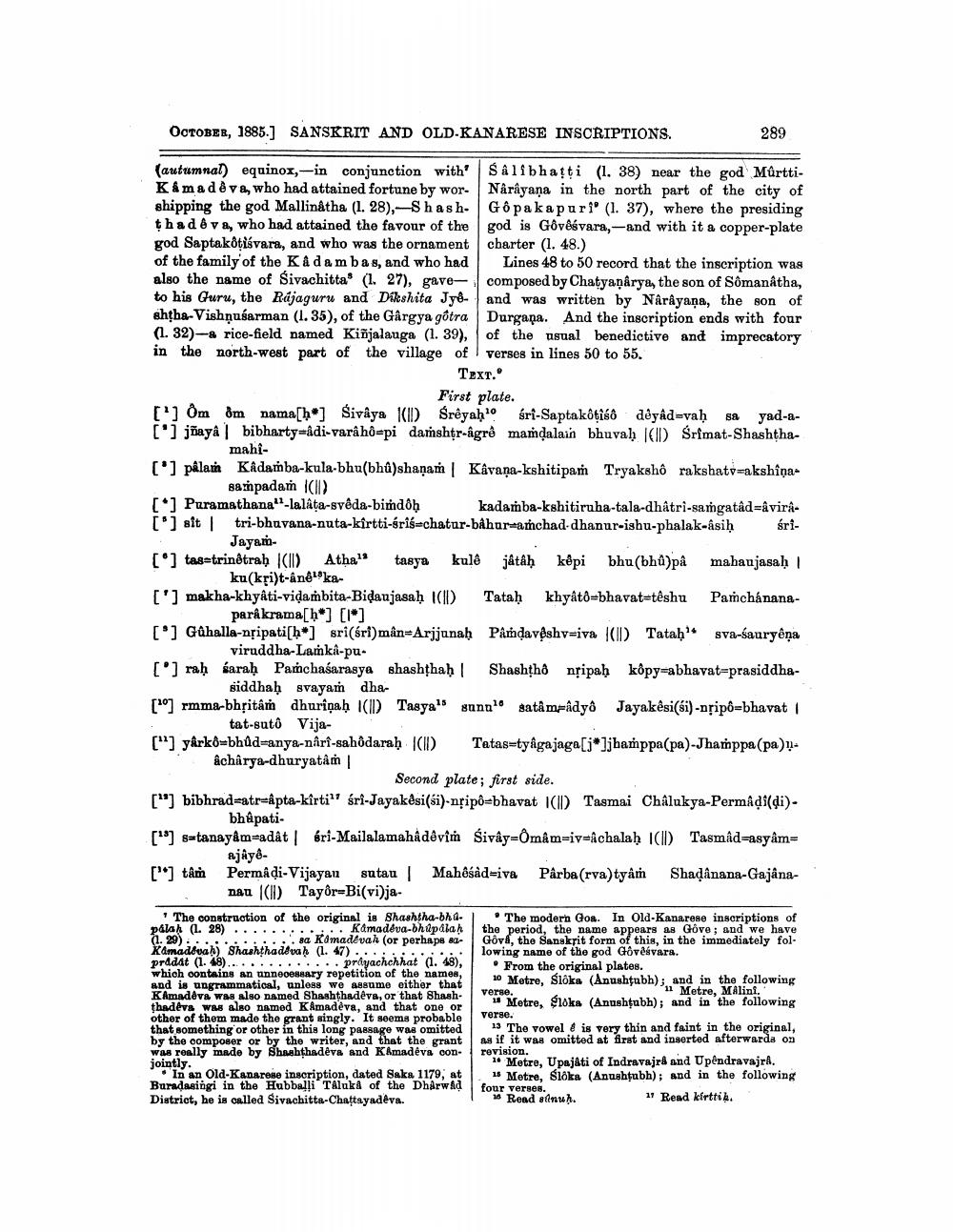________________
OCTOBER, 1885.] SANSKRIT AND OLD-KANARESE INSCRIPTIONS.
289
(autumnal) equinox, -in conjunction with Salibhatti (1. 38) near the god Mürtti. Kamadeva, who had attained fortune by wor- Nåråyaņa in the north part of the city of shipping the god Mallinåtha (1. 28), Shash. Gôpa ka puri' (1. 37), where the presiding thad & va, who had attained the favour of the god is Gôvêśvara, -and with it a copper-plate god Saptakotisvara, and who was the ornament charter (1. 48.) of the family of the Kadambas, and who had Lines 48 to 50 record that the inscription was also the name of Sivachitta (1. 27), gave- composed by Chatyanarya, the son of Sômanatha, to his Guru, the Rájaguru and Dikshita Jyo- and was written by Narayana, the son of shtha-Vishņuśarman (1.35), of the Gârgya gôtra Durgana. And the inscription ends with four (1. 32)-& rice-field named Kiñjalauga (1. 39), of the usual benedictive and imprecatory in the north-west part of the village of verses in lines 50 to 55.
Text.
First plate. ['] Om Om nama[ho] Śivậya kl Śrêyah sri-Saptakôtisô dêyâd-vaḥ sa yad-a(') jmaya bibharty=&di-varâhô=pi damshtr-âgre mandalain bhuvah ICID Srimat-Shashtha
mahî(') pålam Kadamba-kula-bhu(bhû)shaņam | Kâvana-kshitipa Tryakshô rakshatvrakshîna
Barnpadam (II) Puramathanal-lalâta-svéda-bimdoh kadamba-kshitiruha-tala-dhâtri-samgatád=&vira[] sit tri-bhuvana-nuta-kirtti-sris-chatur-båhureamchad dhanur-ishu-phalak-asih śri
Jayam[] tasetrinotrah III) Atha" tasya kulê játaḥ képi bhu(bhu)på mahaujasah
ku(kri)t-âneska['] makha-khyâti-vidambita-Bidaujasah ICD Tataḥ khyâtô=bhavat=téshu Pamchanana
[•] makhamba hikarama[ho] [!?!) mån-Ar
[] Gühalla-nțipati[h*] sri(srl)mån=Arjjanah Påmdavęshv=iva (1) Tatah sva-sauryêņa
viruddha-Lamki-pu. [') raḥ sarah Pamchaśarasya shashthah | Shashthô nțipah kôpy=abhavat=prasiddha
siddhah svaya dha[*] rmma-bhritâm dhuriņaḥ ID Tasya' suna" satâm-adyô Jayakêsi(ći) -nțipô=bhavat
tat-suto Vija("] yêrko=bhůd=anya-nârî-sahôdaraḥ ICID Tatas-tyagajaga[j*]jhamppa(pa)-Jhamppa (pa)ừ. acharya-dhuryatâm
Second plate; first side. ["] bibhraduatr=&pta-kîrti" śri-Jayakési(si)-nțipô=bhavat ICID Tasmai Châlukya-Permadi(di).
bhepati. ["') satanayâm-adât éri-Mailalamahadevim sivây=Omâm-iv-achalah ICID Tasmad-asyâm=
sjåyd[*] tâm Permâļi-Vijayau sutau | Mahêśåd=iva Parba (rva)tyám Shadânana-Gajana
nau ICI) Tayôr=Bi(vi)jaThe construction of the original is Shashtha-bh-1 . The modern Gos. In Old-Kanarese inscriptions of palak (. 28)... .
... Kamadeva-bhupalah the period, the name appears as Gove; and we have Kamadevah (or perhaps -
Gove, the Sanskrit form of this, in the immediately fol
lowing name of the god Govešvara. prddat (1. 48).............. priyachchhat a. 48).
. From the original plates. which contains an unnecessary repetition of the names, and is ungrammatical, unless we assume either that
10 Metre, Slóka (Anushţubh), and in the following Kamadeva wa also named Shashthadeva, or that Shash
11 Metre, MAlini. verse.
1 Metre, sloka (Anushţubh); and in the following thadeva was also named KAmadeva, and that one or
verse. other of them made the grant singly. It seems probable that something or other in this long passage was omitted
13 The vowel & is very thin and faint in the original, by the composer or by the writer, and that the grant as if it was omitted at first and inserted afterwarda on was really inade by Shoahthadeva and Kimadeva con revision. . jointly.
1 Metre, Upajati of Indravajra and UpendravajrA. In an Old-Kanarese inscription, dated Saka 1179, at 15 Metre, sioka (Anushțubh); and in the following Buradasingi in the Hubballi Taluk of the Dharwad four verses. District, he is called Sivachitta-Chattayadeva.
16 Read anun.
11 Read kirttik.
1. 20)
sheshthadtva
(1. 47).
ht . 49).




